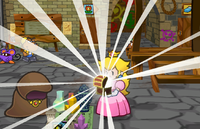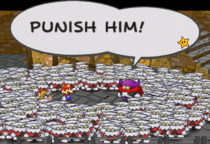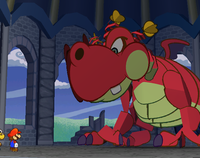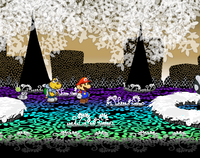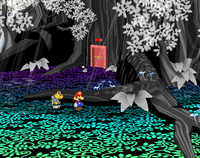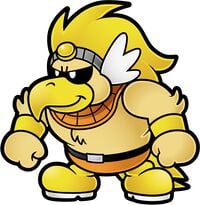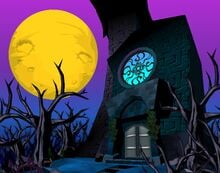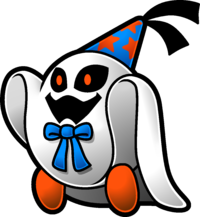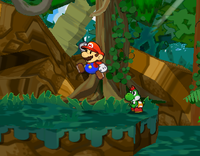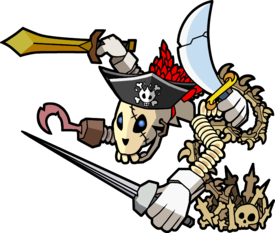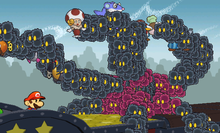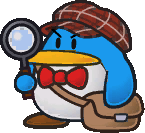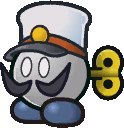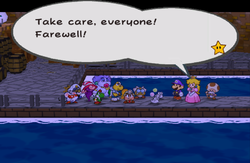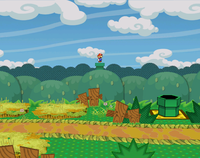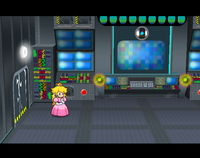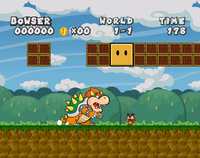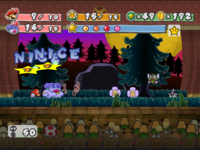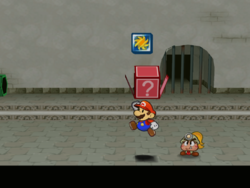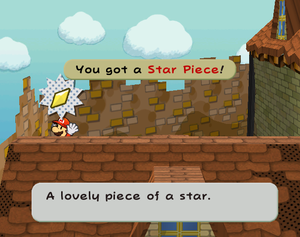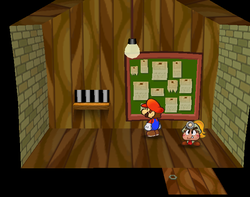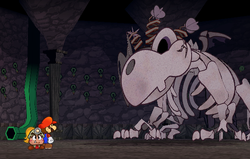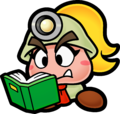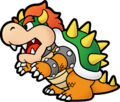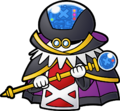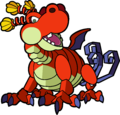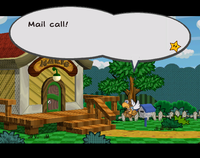Paper Mario: The Thousand-Year Door
This article is under construction. Therefore, please excuse its informal appearance while it is being worked on. We hope to have it completed as soon as possible.
- This article is about 2004 Nintendo GameCube game. For the Nintendo Switch remake, see Paper Mario: The Thousand-Year Door (Nintendo Switch).
| Paper Mario: The Thousand-Year Door | |||||||||
|---|---|---|---|---|---|---|---|---|---|
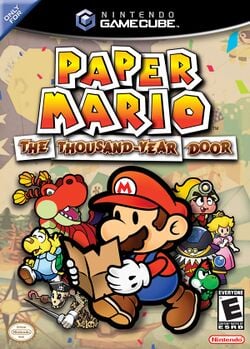 For alternate box art, see the game's gallery. | |||||||||
| Developer | Intelligent Systems | ||||||||
| Publisher | Nintendo | ||||||||
| Platform(s) | Nintendo GameCube | ||||||||
| Release date | Original release Template:Release Player's Choice Template:Release[?] | ||||||||
| Language(s) | English (United States) French (France) German Spanish (Spain) Italian Japanese | ||||||||
| Genre | RPG | ||||||||
| Rating(s) |
| ||||||||
| Mode(s) | Single player | ||||||||
| Input | Nintendo GameCube:
| ||||||||
Paper Mario: The Thousand-Year Door is the second installment in the Paper Mario series. Released for the Nintendo GameCube in 2004, the game is an RPG as the first Paper Mario, featuring both turn-based battles and puzzle and platforming-focused challenges on the overworld as well as collaborating with a party of friendly characters that subsequently join on the quest, known as partners.
The story has Mario travel to the ramshackle town of Rogueport to meet Princess Peach after news she acquired a map leading to an ancient treasure. He soon finds that Peach has been kidnapped again, and comes in conflict with the X-Nauts, a malevolent secret society. Mario's quest has him collect the seven Crystal Stars, mysterious artifacts of great power that are linked to an ancient evil sealed deep below Rogueport.
Paper Mario: The Thousand-Year Door greatly expands on the battle system, with new features such as more fleshed-out partners who now have their own health pool, and the ability to negate all damage inflicted by enemy attacks through Superguarding. An audience now watches the battles — spectators may mess with the fights in ways that help or hinder the player. On the overworld, Mario now has the ability to fold into various paper forms, allowing him to explore deeper and solve puzzles. The game also has intermissions between each Chapter, in which the player assumes the role of Peach, as well as of Bowser, both of whom have their own stories that complement the main plot.
A follow-up titled Super Paper Mario was released for the Wii in 2007. Paper Mario: The Thousand-Year Door is the only game in the series to share the same battle system as the original Paper Mario, as Super Paper Mario is a platformer with RPG elements and subsequent installments (starting with 2012's Paper Mario: Sticker Star) retooled many aspects of the series.
A remake of the same name is set to be released on the Nintendo Switch in 2024.
Plot
Prologue: A Rogue's Welcome
The adventure begins when Princess Peach goes on a cruise to Rogueport where she meets a hooded woman, and buys a box which contains a map. She sends this to Mario, along with a letter asking him to help her search for the map's treasure. Soon after that, unbeknownst to Mario and the player, she is kidnapped by Sir Grodus. Mario receives the letter with the map and decides to help her, and thus boards a ship to Rogueport.
Shortly after Mario reaches Rogueport, he finds Lord Crump attempting to interrogate Goombella about the Crystal Stars. Mario intervenes and Lord Crump tries to defeat him. After defeating the X-Naut general and escaping from the X-Nauts, Goombella introduces herself, and Mario explains his quest to her. As Goombella is also searching for the map's treasure, she decides to join Mario. Then, Goombella suggests to go to Professor Frankly's house, to consult him and show him the map. At the professor's house, Frankly explains that the map is related to the legend of the treasure of the Thousand-Year Door, and that, to obtain the treasure, one must first open the door with the seven Crystal Stars. Said objects can be found by holding the Magical Map before the Thousand-Year Door, which is located in the town's sewers. So, Mario holds the map before the Thousand-Year Door, revealing the location of the first Crystal Star.
Names in other languages
| Language | Name | Meaning | Notes |
|---|---|---|---|
| Japanese | プロローグ ゴロツキタウンへようこそ![?] Purorōgu: Gorotsuki Taun e Yōkoso! |
Prologue: Welcome to Rogueport! | |
| French | Prologue: Bienvenue à Port-Lacanaïe![?] | Prologue: Welcome to Port-Lacanaïe! | |
| German | Prolog: Willkomen in Rohlingen[?] | Prologue: Welcome to Rohlingen | |
| Italian | Prologo: Benvenuti a Fannullopoli[?] | Prologue: Welcome to Idler City | |
| Spanish | Prólogo: Bienvenidos a Villa Viciosa[?] | Prologue: Welcome to Vicious Village |
Chapter 1: Castle and Dragon
Mario and Goombella show the updated map to Professor Frankly, who reveals that the first Crystal Star is in Petal Meadows. To reach this place, they must find a pipe in Rogueport Sewers. After finding it, Mario and Goombella arrive in Petal Meadows, where they see Hooktail and her castle. The duo stops at a nearby village called Petalburg and discover from the mayor that the dragon Hooktail has been terrorizing the village. The mayor tells them that Hooktail guards a Crystal Star in her castle, and that to access it, they must obtain the two stone keys in Shhwonk Fortress, an ancient stone fort past Petalburg. After finding them, Mario and Goombella march to Hooktail's castle, with Koops in tow (who wants to defeat Hooktail to avenge his dead father and become stronger). After navigating through the castle's traps with the help of Koops, they encounter the dragon and defeat her, allowing Koops's father to get out of the dragon's gut and present Mario with the Diamond Star.
Somewhere else, it is revealed that Princess Peach was abducted by the X-Nauts. When an X-Naut tells Sir Grodus someone got the first Crystal Star, Peach accidentally blurts out Mario's name. Grodus hears this and orders the Shadow Sirens to steal the map in Mario's possession. Peach then meets TEC-XX, the X-Naut base's computer, who develops an interest in Peach's concept of love, and asks for her help in understanding it. Peach agrees; in exchange, TEC lets her send e-mails to Mario.
Afterward, the scene focuses on Bowser's Castle, where Kammy Koopa tells Bowser about Mario's quest to find the Crystal Stars and Peach's abduction, things that motivate Bowser to hunt for the Crystal Stars and kidnap Peach back. Bowser and Kammy then head for Rogueport.
Back in Petalburg, the group receives an e-mail from Peach, who informs them that she has been kidnapped. Mario and company head back to the Thousand-Year Door to reveal the location of the next Crystal Star.
Storyline text
Mario and friends finally got a Crystal Star in the castle after defeating Hooktail. Koops even reunited with his long-lost father, whom he thought was dead. Yet they were unable to learn anything about the whereabouts of the princess. Where could Princess Peach be? Yes... Mario's adventure has only just begun.
Names in other languages
| Language | Name | Meaning | Notes |
|---|---|---|---|
| Japanese | ステージ1 マリオとお城とドラゴンと[?] Sutēji 1: Mario to Oshiro to Doragon to |
Stage 1: With Mario, the castle and the dragon | |
| French | Chapitre 1: Mario + château + dragon[?] | Chapter 1: Mario + castle + dragon | |
| German | Kapitel 1: Lohgards Drachenburg[?] | Chapter 1: Dragon Lohgard's Castle (Lohgard is Hooktail's German name.) |
|
| Italian | Scena I: Mario, il castello e la dragonessa[?] | Scene 1: Mario, the castle and the dragon | |
| Spanish | Acto 1: El bueno, el feo y el malo[?] | Act 1: The Good, The Ugly and The Bad |
Chapter 2: The Great Boggly Tree
The second Crystal Star is revealed to be in the Great Tree, home of small creatures known as Punies, deep inside Boggly Woods. When searching for the pipe leading to Boggly Woods in Rogueport Sewers, Mario and his partners encounter Punio, who tells them that the X-Nauts have invaded the Great Tree, capturing most of the Punies and that the Jabbies, the Punies' enemies, have allied with the X-Nauts and are trying to kick the Punies out of the Great Tree. Mario and company decide to help out the Punies, and therefore Punio leads the group to the Boggly Woods. After getting there, Mario and company encounter the Shadow Sirens with a necklace, who do not recognize him due to having lost a sketch of him. The group continues and arrives at the Great Tree. However, they realize that the tree is locked. Punio suggests they find Madame Flurrie, who can help them find the Tree's secret entrance. Despite this, upon reaching her home, Flurrie reveals she has lost her necklace and does not want anyone to see her without it. Thus, Mario and friends return to the Shadow Sirens and defeat them, this way retrieving the necklace. After returning it to Flurrie, she joins them in their quest. The group finds the secret entrance with her help and manages to enter the Tree; after freeing the locked Punies with the aid of a special orb and after solving the Great Tree's puzzles and defeating the Jabbies, they reveal the second Crystal Star at the bottom of the Tree. There, Lord Crump snatches it, and activates a time bomb to blow up the Tree. Upon following him to the entrance, he stops the bomb and uses Magnus von Grapple to fight the heroes, but he is defeated by the group. As a result, the X-Nauts evacuate the Tree and Mario and company obtain the Emerald Star.
At the X-Naut headquarters, the X-Nauts notify Sir Grodus that Mario has taken the Emerald Star. TEC-XX calls for the Princess, and asks her to dance with him. TEC then lets Peach e-mail Mario.
Meanwhile, Bowser heads for Petalburg, since Kammy tells him that Peach was seen there. After crossing Petal Meadows, he arrives in the town, and upon spotting what he thinks is Peach, he tries talking to her, but she is revealed to be merely a poster owned by a local Koopa Troopa.
As Mario and his team move on, they receive another e-mail from Peach, who tells them that the X-Nauts are also searching for the Crystal Stars. Mario and his team reveal the location of the next Crystal Star, and they visit Professor Frankly for details.
Storyline text
And so, after pummeling Lord Crump, Mario obtained the second Crystal Star... With the X-Nauts gone, peace once again prevailed throughout the Great Tree. The Boggly Woods echoed with the Puni songs of joy. But... this may not be the last our hero hears from the vile X-Nauts. They will surely continue to stand in Mario's way and try to put a stop to his efforts...
Names in other languages
| Language | Name | Meaning | Notes |
|---|---|---|---|
| Japanese | ステージ2 ふしぎの森の大きな木[?] Sutēji 2: Fushigi no Mori no Ōkina Ki |
Stage 2: The Big Tree of the Mysterious Forest | |
| French | Chapitre 2: Un grand arbre[?] | Chapter 2: A great tree | |
| German | Kapitel 2: Der Baum der Bubus[?] | Chapter 2: The tree of the Bubus (Bubu is the German name for the Punies.) |
|
| Italian | Scena II: La Grande Quercia del Bosco Misterioso[?] | Scene 2: The Great Oak of the Mysterious Forest | |
| Spanish | Acto 2: El bosque animado[?] | Act 2: The Animated Forest |
Chapter 3: Of Glitz and Glory
The third Crystal Star appears in a large arena on a floating town. To reach Glitzville, Mario and the gang must visit Don Pianta. He offers them the ticket they need after doing him a favor. Once Mario and his team arrive in Glitzville, they enter the Glitz Pit, a popular place in which fighters brawl, and spot the Crystal Star on the Champ's Belt, held by Rawk Hawk, the current champion. They sign up in the Pit, battle through the ranks, and eventually gain a newborn Yoshi as a partner. Soon, a mysterious figure known only as "X" starts sending cryptic e-mails to Mario. The e-mails lead Mario and his partners to discover that the Star on the belt is a fake, and that the real Crystal Star is being used by Grubba, the promoter of the Glitz Pit. Mario and company expose his wrongdoings and chase him into the arena, where he transforms into Macho Grubba in order to eliminate Mario and his friends. Nonetheless, the group manages to defeat him. After the battle, Jolene, Grubba's assistant, appears and reveals herself as the mysterious X, explains her story, and gives Mario the Gold Star.
At the X-Naut base, TEC-XX asks Peach to go ask Grodus a question relating to his plans. The Princess goes undercover in an X-Naut disguise and learns that Grodus is plotting to use the Crystal Stars to take over the world. TEC allows her to send this message to Mario.
Meanwhile, Bowser and Kammy are searching for one of the Crystal Stars in the Great Tree, where they discover that Mario already obtained it.
Mario and company receive Peach's message; they promptly reveal the fourth Crystal Star's location.
Storyline text
Glitzville's seamy underside was a dark, dangerous place seething with conspiracy... With the help of the lovely Ms. Jolene, Mario revealed Grubba's true identity... And acquired the third Crystal Star by defeating the monstrous Macho Grubba. Grubba had used the power of the Crystal Star to run his power-draining machine... What other hidden powers might these strange and mystical items possess?
Names in other languages
| Language | Name | Meaning | Notes |
|---|---|---|---|
| Japanese | ステージ3 もえよ!チャンピオン![?] Sutēji 3: Moeyo! Chanpion! |
Stage 3: Get fired up! Champion! | |
| French | Chapitre 3: Vas-y champion![?] | Chapter 3: Go champion! | |
| German | Kapitel 3: Kampf der Champions[?] | Chapter 3: Clash of the Champions | |
| Italian | Scena III: Forza, campione![?] | Scene 3: Come on, champion! | |
| Spanish | Acto 3: El rey de los luchadores[?] | Act 3: The King of Fighters |
Chapter 4: For Pigs the Bell Tolls
Professor Frankly tells the group that the Crystal Star is located in Creepy Steeple, near Twilight Town. When Mario and company arrive in Twilight Town, they discover that the village is under a curse cast by a monster who lives in the steeple. Using a new power, the group reaches the steeple, and battles the monster. During the battle, the monster uses an ability to steal Mario's name and body, while Mario is transformed into a shadowy version of himself. Mario's partners claim the Crystal Star and leave with whom they think is Mario. All the while, the Shadow Sirens are in Twilight Town, planning on defeating Mario and his partners with their new weapon: the Superbombomb. In spite of this, Beldam seems to have lost it, prompting her to blame Vivian and to force her to search for it. The real Mario returns to Twilight Town, and helps Vivian with her problem. Out of gratitude, she joins Mario's party. They eventually discover from the monster's parrot that the monster's name is Doopliss. After telling Doopliss his name, he is weakened and flees to Creepy Steeple. Mario and Vivian chase him there and they fight once more. Mario and his new partner defeat Doopliss, allowing Mario to regain his name and body and obtain the Ruby Star.
At the X-Naut base, TEC-XX requests the Princess to participate in a sort of "quiz show" with him. By doing this, she discovers what the "treasure" of the Thousand-Year Door really is: the soul of an ancient demon. The Princess then relays this information to Mario.
In the meantime, Bowser continues his quest for the Crystal Stars by flying to Glitzville in his Koopa Clown Car. It malfunctions halfway there, though, and he must travel underwater in order to return to Rogueport. After he gets there and meets up with Kammy, he orders her to continue her research on the Crystal Stars.
Back in Twilight Town, Mario and his friends receive the message from Peach. They reveal the whereabouts of the next Crystal Star and visit Professor Frankly for details.
The English name for Chapter 4, as well as its Japanese, Spanish, Italian, and French translations, are referencing the Ernest Hemingway novel, For Whom the Bell Tolls. The Japanese name is also possibly a reference to the Japan-exclusive game Kaeru no Tame ni Kane wa Naru co-developed by Intelligent Systems, which involves a bell capable of transforming frogs into people.
Storyline text
(fake) Mario defeated the scourge of Creepy Steeple and found the fourth Crystal Star. The people of Twilight Town have surely recovered from their awful curse by now. At this rate, Mario's quest to collect all seven Crystal Stars will be done in no time! With his back to Creepy Steeple, Mario sets out toward his bright future...
(real) Mario defeated the rogue who had stolen his name and appearance. Now Mario has four Crystal Stars. That leaves a mere three more to find! And THAT means his quest to collect all of the Crystal Stars is more than half over! Now Mario heads off toward his next adventure with his new friend, Vivian... ...But what about Beldam and Marilyn? And what became of the doppelganger, Doopliss?
Names in other languages
| Language | Name | Meaning | Notes |
|---|---|---|---|
| Japanese | ステージ4 ブタのためにカネはなる[?] Sutēji 4: Buta no Tame ni Kane wa Naru |
Stage 4: For Pigs the Bell Tolls; name is a parody on For Whom the Bell Tolls and Kaeru no Tame ni Kane wa Naru | |
| French | Chapitre 4: La cloche à cochons[?] | Chapter 4: The pig bell | |
| German | Kapitel 4: Die Glocke der Spukabtei[?] | Chapter 4: The bell of the Spook Abbey | |
| Italian | Scena IV: Per chi suona la campana[?] | Scene 4: For whom the bell tolls | |
| Spanish | Acto 4: ¿Por quién dobla la campana?[?] | Act 4: For Whom Does the Bell Toll? |
Chapter 5: The Key to Pirates
The fifth Crystal Star is located deep within a pirate lair on the southern island of Keelhaul Key. To reach the island, Mario enlists the help of Flavio and Admiral Bobbery. They sail to the island with some Toads, Pa-Patch, and Lord Crump in disguise (known as "Four-Eyes"). On their way there, Mario and company are attacked by Cortez's Embers, which shipwreck them on Keelhaul Key. Later on, some of the crew members are attacked by more Embers, and Bobbery sacrifices himself to save them. Bobbery says he is close to death, and after giving him his last request, they find out that he just fell asleep. As soon as Mario wakes him, he joins Mario's party. With the aid of Bobbery, and Flavio's Skull Gem, Mario and company enter Pirate's Grotto. After solving some puzzles, and gaining another ability from a black chest, they finally enter Cortez's ship. Following a battle, Cortez gives Mario his Sapphire Star. Subsequently, Lord Crump abandons his disguise and tells Mario that he will attack him with his ship's cannons until he hands over the Crystal Star. With the help of Cortez's ship and Flavio's Skull Gem, they defeat the invading X-Nauts, along with their leader.
Back at the X-Naut base, TEC-XX wishes to gain access to a disk in Sir Grodus's room, and requests Peach to help him. With the aid of an invisibility potion, she secures the disk for TEC, and thus he promises to analyze the data. Peach then sends yet another e-mail to Mario, informing him of this development.
Meanwhile, in Twilight Town, Bowser and Kammy Koopa run into Lord Crump. The three get into an argument, which escalates to an armed confrontation between the Koopa Troop and the X-Nauts. Bowser inadvertently ends up igniting the Superbombomb, knocking out both armies.
Back at Keelhaul Key, Cortez ferries Mario and his teammates to Rogueport. Mario gets the e-mail from Peach, telling them about what TEC is analyzing. Mario and his team then reveal the next Crystal Star's location, and visit Professor Frankly for information.
Storyline text
Cortez, scourge of the seas... Mario soundly defeated this fearful spirit and claimed the Crystal Star. Perhaps the peaceful citizens of the world no longer need fear Cortez and his fell ship... The only problem remaining is how Mario will escape this isolated island... And could there be another problem still, hiding beneath our hero's nose?
Names in other languages
| Language | Name | Meaning | Notes |
|---|---|---|---|
| Japanese | ステージ5 トロピコアイランドの大海賊[?] Sutēji 5: Toropiko Airando no Dai Kaizoku |
Stage 5: The Great Pirate of the Tropic Island | |
| French | Chapitre 5: Pirate de Tropatroce[?] | Chapter 5: Pirate of Tropatroce | |
| German | Kapitel 5: Der Schatz des Piraten[?] | Chapter 5: The pirate's treasure | |
| Italian | Scena V: Il grande pirata dell'Isola Tropico[?] | Scene 5: The Great Pirate of the Tropic Island | |
| Spanish | Acto 5: La isla del tesoro[?] | Act 5: Treasure Island |
Chapter 6: 3 Days of Excess
The sixth Crystal Star is in Poshley Sanctum, located in the ritzy town of Poshley Heights. The only way to get there is by riding on the famous Excess Express. After doing Don Pianta another favor, he gives Mario a train ticket. During the first day on the Excess Express, Mario and his team witness several mysterious events, including thefts of items and messages threatening to blow up the train. On their second day of travel, Pennington, a penguin detective, helps Mario and his friends solve the crimes, and together, they manage to capture a fake Zip Toad who was really Doopliss in disguise, and the one who attempted to halt the train by causing an explosion with some stolen items. At sundown, when the train stops at Riverside Station for refuel, Doopliss escapes capture. Mario and company find that the drawbridge has been lifted, preventing the Excess Express from continuing its route. The gang enters Riverside Station and flips the switch to bring the drawbridge back down. Also, they discover that a group of Smorgs had lifted the bridge. On the third and final day of the journey, a stowaway Smorg monster attacks the train, kidnapping all of its passengers. Mario and his friends defeat the creature, rescuing the passengers in the process, and finally reach Poshley Heights. They venture into Poshley Sanctum, a museum that happens to belong to Pennington. The Shadow Sirens, who happen to be already inside, snatch what appears to be the Garnet Star and flee. However, Pennington reveals that what they stole was a fake, and lets Mario find where the real Crystal Star is. After some exploring, Mario and company manage to find the real Garnet Star.
Back at the X-Naut base, the X-Nauts tell Grodus that Mario now possesses six of the seven Crystal Stars. They also tell him of TEC's betrayal. Just then, TEC makes the information he gained from Grodus's data disk known to the Princess, and prepares to help Peach escape. Before he is able to, Grodus enters with two X-Nauts and orders them to initiate a data-wipe procedure of TEC's memory. TEC tells Peach "I love you" just before he is shut down.
Meanwhile, Bowser is searching for another Crystal Star, and upon clearing an underground course, he reaches Rawk Hawk's workout room, where he stumbles across the Champ's Belt. However, he quickly learns that it does not bear a real Crystal Star, just a glass fake.
Mario and his team return to Rogueport and receive an e-mail from Peach, telling them about her being held on the moon, and what the X-Nauts plan to do with her, but the last and most grim part of the message is cut off due to TEC being shut down. Back in Rogueport, Mario and company reveal the next Crystal Star's location and visit Professor Frankly for details.
Chapter 6 appears to allude to Murder on the Orient Express, which also involves several peculiar passengers on a train where a crime takes place.
Storyline text
Mario found the sixth Crystal Star, hidden craftily in the Poshley Heights sanctum. Now only one Crystal Star remains... But our hero still does not know where Princess Peach is being held. Where could the last Crystal Star be? And where is Peach being held? Hoping this Crystal Star might yield answers, Mario and friends return to Pennington.
Names in other languages
| Language | Name | Meaning | Notes |
|---|---|---|---|
| Japanese | ステージ6 リッチリッチエクスプレス3日間[?] Sutēji 6: Ritchi Ritchi Ekusupuresu Mikka-kan |
Stage 6: The Rich Rich Express 3 days | |
| French | Chapitre 6: Dans le Crésus Express![?] | Chapter 6: On the Crésus Express! | |
| German | Kapitel 6: Reise im Glimmer-Liner[?] | Chapter 6: Travel in the Excess Express | |
| Italian | Scena VI: Tre giorni sul Fasto-Express[?] | Scene 6: Three days on the Pomp-Express | |
| Spanish | Acto 6: Misterio en el Ricachón Exprés[?] | Act 6: Mystery in the Rich Man (Train) Express |
Chapter 7: Mario Shoots the Moon
The last Crystal Star appears to be on the moon. To reach it, Mario and his companions travel to Fahr Outpost to find a cannon to shoot them there. After searching for Goldbob and General White, whose blessings are needed to operate the firearm, Mario and company enter the cannon and are shot to the moon. Once there, the group discovers the X-Naut Fortress. After arriving at its deepest part, they face Lord Crump, who brags about his latest creation — Magnus von Grapple 2.0, and tries once again to defeat Mario and company. Even so, he is thwarted, and the Crystal Star in his possession is claimed by them.
At the same time, Bowser is looking for another Crystal Star in the Poshley Sanctum. A Paragoomba flies in and reports to Bowser that Mario has collected every Crystal Star and is heading for the Thousand-Year Door, which contains a great treasure. Bowser announces that he will steal this treasure and trounce Mario.
As Mario and his allies prepare to leave the fortress, they discover that all of the doors have been locked, except for one. In this room, the heroes find TEC, who is running on backup power. He recognizes Mario and tells him to rescue the Princess, who has been taken to the Palace of Shadow, a place that lies beyond the Thousand-Year Door. He then activates an emergency transporter, which Mario and company employ, right before the fortress explodes, along with TEC. The group is transported to a room in Rogueport Sewers. After exiting the room, Doopliss disguised as Professor Frankly meets them and urges them to open the Thousand-Year Door, lying that Grodus went through it with Peach.
Storyline text
The last Crystal Star had been hidden in the X-Naut hideout on the moon... But by the time Mario recovered it, Peach had already been taken away... Where could Peach be now? And what of the elusive Grodus? Perhaps he holds the key to the remaining puzzle... Mario finally has all seven Crystal Stars... Where will they lead him next?
Names in other languages
| Language | Name | Meaning | Notes |
|---|---|---|---|
| Japanese | ステージ7 はるかなる月を目ざして[?] Sutēji 7: Harukanaru Tsuki o Mezashite |
Stage 7: Aiming at the Distant Moon | |
| French | Chapitre 7: Voyage sur la Lune[?] | Chapter 7: Journey to the Moon | |
| German | Kapitel 7: Der Weg zum Mond[?] | Chapter 7: The Way to the Moon | |
| Italian | Scena VII: Viaggio sulla Luna[?] | Scene 7: Journey to the Moon | |
| Spanish | Acto 7: Objetivo: la Luna[?] | Act 7: Target: the Moon |
Chapter 8: The Thousand-Year Door
After Mario has obtained all seven Crystal Stars, the time has come to open the Thousand-Year Door and enter the Palace of Shadow to rescue Princess Peach from Sir Grodus.
Mario and his friends open the Thousand-Year Door with the seven Crystal Stars, allowing them to enter the Palace of Shadow. The palace itself is full of enemies, puzzles, and traps. Eventually, Mario and company battle and beat a dragon named Gloomtail, Hooktail's older brother, this way making him relinquish the key to access the Riddle Tower. Upon solving the Tower's puzzles, a secret passage — which leads deeper into the Palace — is opened. Mario and his party continue down that path, but not before defeating the Shadow Sirens, who try to get rid of them. Finally, Mario and company enter the throne room of the Palace, where they confront Sir Grodus, whom they engage in battle. They are able to best him, yet Grodus reveals a captive Peach, whom he uses as a hostage to freely attack Mario and company. Suddenly, Bowser and Kammy drop in unexpectedly and land on top of Grodus. The duo seizes the opportunity to fight Mario, but are foiled in the end. Nevertheless, Grodus uses the distraction of the battle to bring Princess Peach into the deepest part of the Palace. There, he opens a sealed coffin and frees the Shadow Queen, the ancient demon of legend. Beldam appears all of a sudden and announces that she was the one who orchestrated the plot to free her mistress. The Shadow Queen refuses to be controlled by Grodus, and fries him with a lightning bolt, apparently killing him. The Queen proceeds to possess Princess Peach, using her as a vessel to sustain her life. The world is then covered in darkness. Mario and his allies challenge the Queen, but she eventually decides to fight in her real form, in which she is invincible. She proves too much for the group to handle, until the Crystal Stars abruptly react to the evil of the Queen and fly throughout the world, each returning to where they were found, giving the people of the world a chance to cheer on Mario and his party. Their hope breaks through the Queen's invulnerability, and this also lets Peach give the heroes the last of her power. Strengthened, the heroes seal the Shadow Queen forever, saving the world.
Goombella later sends Mario a message, explaining what everyone has done: she now works with Professor Frankly, while Koops plans on becoming the mayor of Petalburg. Flurrie has returned to the stage and enacts "Paper Mario" as her comeback smash, and Doopliss plays the role of Mario. The Yoshi fights in the Glitz Pit as the "Great Gonzales Jr.", whereas Vivian has forgiven her sisters and lives in Twilight Town. Admiral Bobbery sails the seas with Cortez, and Ms. Mowz still runs her Lovely Howz of Badges. Lord Crump, Grodus and the X-Nauts survived and are spending their time, without causing trouble, in Poshley Heights. Somehow, TEC survived as well, and hopes to see the Princess again one day. The game ends when the Princess visits the Mario Bros. with another treasure map, and requests Mario's help in finding it.
Names in other languages
| Language | Name | Meaning | Notes |
|---|---|---|---|
| Japanese | ステージ8 スターストーンと伝説の宝[?] Sutēji 8: Sutā Sutōn to Densetsu no Takara |
Stage 8: The Star Stones and the Legendary Treasure | |
| French | Chapitre 8: Le trésor légendaire[?] | Chapter 8: The legendary treasure | |
| German | Kapitel 8: Die Legende vom Schatz[?] | Chapter 8: The treasure's legend | |
| Italian | Scena VIII: Le Gemme Stella e il Tesoro Leggendario[?] | Scene 8: The Star Gems and the Legendary Treasure | |
| Spanish | Acto 8: El destino en sus manos[?] | Act 8: The fate in their hands |
Gameplay
It has been requested that this article be rewritten and expanded to include more information. Reason: Need Mario's stats and upgrades
In terms of gameplay, Paper Mario: The Thousand-Year Door brings over the core mechanics of the N64 original and enhances them. Mario now has a voice used for jumping and attacking, and starts his adventure with a hammer. Action Commands can also be performed from the start. However, he has lost the ability to Spin Dash from the original game.
The partner system is also enhanced. Unlike the original, where partners had a simple fine/injured status system, this game gives partners their own Heart Points. As such, partners can fall in battle, and items such as the Mushroom can be used on them as well. Several partners are similar to ones seen in Paper Mario, like Koops being the counterpart of Kooper, but generally have more abilities available. Timed moves are more abundant in this game. In addition, battles are set up on a stage, like a play; this greatly affects battles, and characters can interact with the audience and stage.
Background
Another element introduced in Paper Mario: The Thousand-Year Door is the background scenery, which is actually accessible for Mario through certain pipes. Several places which only appear in the background can be visited this way, some of which include Hooktail Castle, the Great Tree, the X-Naut Fortress, and Merlee's house in the Rogueport Sewers. This feature was carried over to the next game in the series, Super Paper Mario. Certain abilities are disabled here, however: Mario's partners cannot be used in the background, Mario cannot move to a different screen/area, and he also cannot walk past any buildings.
Intermissions
After each Chapter is completed, two intermission scenes precede the beginning of the next. The player can save their progress before and after each intermission.
Princess Peach intermissions
The first intermission allows the player to control Princess Peach, similarly to the intermissions from Paper Mario. These intermissions follow Peach as she is held captive in the X-Naut Fortress, as well as her interactions with the fortress's main computer, TEC-XX, who had a malfunction upon discovering Peach, causing him to fall in love with her. The intermissions also provide more context to the X-Nauts, their motive for kidnapping Peach, and their greater overall plans. At the end of each intermission, Peach sends a message to Mario's Mailbox SP.
Bowser intermissions
The Peach intermission is followed by a Bowser intermission, a new addition to Paper Mario: The Thousand-Year Door. These intermissions serve as comic relief to contrast the more serious nature of the Peach intermissions. Each intermission follows Bowser and Kammy Koopa; having discovered that Mario is collecting the Crystal Stars and Princess Peach has been kidnapped, Bowser sets off to find the Crystal Stars first and kidnap Peach himself. However, Bowser usually visits the places Mario has been to one chapter before, and his search for Peach and the Crystal Stars in each location he visits ends to no avail.
The Bowser intermissions at the end of Chapter 2, Chapter 4, and Chapter 6 include a side-scrolling platformer level in the style of Super Mario Bros. The levels are called World 1-X, World 2-X, and World 3-X, in reference to the world numbering of Super Mario Bros., with the X being replaced by the number of attempts Bowser has used for the level. Bowser has unlimited lives during each level. Each level is themed after a basic environment from Super Mario Bros. and plays an arrangement of music from that game. Each level also has a time limit of 180 seconds, which kills Bowser if time runs out. If only 30 seconds remain, the "Hurry up!" jingle from Super Mario Bros. plays and the music speeds up. Bowser can also earn points and collect coins in these levels; however, these elements have no effect on gameplay. Each coin Bowser collects is worth 500 points, with the coin count being retained after dying. If the coin count reaches 99, it simply reverts to 0 upon collecting the next coin, without any special effect.
In these levels, Bowser can press ![]() to jump, and can perform a Ground Pound by pressing
to jump, and can perform a Ground Pound by pressing ![]() again in mid-air. He also has the ability to breathe fire by holding
again in mid-air. He also has the ability to breathe fire by holding ![]() , which can defeat enemies and destroy blocks, although he cannot breathe fire in mid-air. The only item that appears in these levels is Meat, which allows Bowser to radically increase his size and take an extra hit from hazards, similar to the effects of a Super Mushroom. However, touching lava or falling into a bottomless pit immediately kills Bowser. Bowser has four possible sizes:
, which can defeat enemies and destroy blocks, although he cannot breathe fire in mid-air. The only item that appears in these levels is Meat, which allows Bowser to radically increase his size and take an extra hit from hazards, similar to the effects of a Super Mushroom. However, touching lava or falling into a bottomless pit immediately kills Bowser. Bowser has four possible sizes:
- An extremely small size, which Bowser reverts to after taking a hit while at his default size.
- A medium size, the default size at which Bowser starts each level.
- A large size, which Bowser grows to after using a piece of Meat from his default size. At this size, Bowser flattens enemies if he stomps on them.
- A gigantic size, which Bowser grows to after using a piece of Meat from his large size. At this size, Bowser starts flashing yellow and becomes invincible similarly to Mega Mario, allowing him to crush everything in his way, including enemies, blocks, and Warp Pipes.
Enemies react to Bowser in different ways: while X-Nauts charge at Bowser, Goombas are scared by him and run away when he approaches them. The end of each level features a flagpole; reaching it completes the level and briefly displays the word "FINISH". There is also a small castle next to the flagpole, as another reference to Super Mario Bros. If Bowser is at an extremely small or medium size, he descends the flagpole and enters the castle; however, if he is large or gigantic, he destroys the flagpole and simply stands next to the castle.
Bowser says a short line when beginning each new attempt of a level.[1] Below is each line in order:
- Ready to roll!
- Lemme at 'em!
- Inconceivable! (World 1 and World 3)/Watery ears! (World 2 only)
- I'm on fire!
- I'm hungry!
- Next time!
- Ain't over yet!
- Charge! (World 1 and World 3)/Beware squids! (World 2 only)
- Good to go!
- Relax!
- Hoo... I'm tired.
- Still in it!
- Rampage time!
- Eh... OK.
- Go time!
- Feel it!
- I'm sleepy...
- Timing, baby!
- Rhythm, baby!
- Feeling good!
- Concentrate!
- GAAAAAAAH!
- Too close!
- Last...gasp!
- Break time.
- Here goes!
- Once more!
- I'm still OK!
- Never give up!
- Gotta do it!
After 30 attempts, Bowser will always say "Gotta do it!" when beginning each subsequent attempt.
Paper abilities
While exploring the game's world, the player encounters black chests, which give Mario special abilities to use in the overworld. All of these abilities are based on the paper element of the game's graphics.
| Paper ability | Location and chapter received | Ability gained |
|---|---|---|
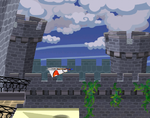 Plane Mode |
Rogueport Sewers (Prologue) | Allows Mario to fold himself into a paper airplane while standing on marked platforms called plane panels, granting him the ability to fly over large gaps. |
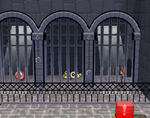 Paper Mode |
Hooktail Castle (Chapter 1) | Allows Mario to turn sideways. Due to being paper-thin, he is able to squeeze through certain narrow passages. |
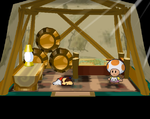 Tube Mode |
Twilight Town (Chapter 4) | Allows Mario to roll up into a short tube, this way being able to fit in low passageways. |
 Boat Mode |
Pirate's Grotto (Chapter 5) | Allows Mario can turn into a paper boat while standing on wooden docks called boat panels, granting him the ability to cross bodies of water. |
Mario's partners
On his adventure, Mario, just like the past game, uses partners. They possess diverse abilities, useful both in and out of battle. Merlon can upgrade a partner by giving him 3 Shine Sprites. Every partner knows two moves at the time of joining the party, learns the third after being upgraded to Super Rank, and masters the final move upon attaining Ultra Rank. Initially, each partner may only be upgraded once, but if Mario finds the Up Arrow in Hooktail's Castle and shows it to Merlon, the wizard will remember that he has an Ultra Stone, subsequently allowing the player to upgrade a partner for a second time.
| Name | Summary | Abilities | Description |
|---|---|---|---|
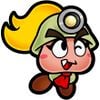 Goombella |
A sassy Goomba who studies at the University of Goom. She is the first character to join Mario (shortly after he defeats Lord Crump), since she, too, is looking for the legendary treasure. She has the same ability to uncover an enemy's stats as Goombario does. | Headbonk 0 FP |
Hits one enemy twice. Does not work on fire enemies, or those with a spiky top. |
| Tattle 0 FP |
Analyzes one enemy and reveals their HP and other statistics. | ||
| Multibonk 3 FP |
Attacks one enemy repeatedly for diminishing damage (minimum 1 HP per hit). Does not work on fire enemies, or those with a spiky top. | ||
| Rally Wink 4 FP |
Allows Mario to perform a second action, at the expense of her own. | ||
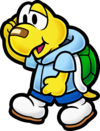 Koops |
A timid Koopa Troopa who lives in Petalburg. To prove to Petalburg that he is not a coward, and to avenge the death of his father, Koopley, he joins Mario's team. He has the same ability Kooper has outside of battle: using his shell toss move to activate switches, grab items and attack enemies, but with a slight upgrade — he can hold his shell in place and then launch it back in the opposite direction. Koops has a Defense Power of 1.
After defeating Hooktail, he finds out that Koopley is not dead after all, but continues traveling with Mario to become stronger. |
Shell Toss 0 FP |
Attacks the frontmost ground-bound or low-hovering enemy. Does not take contact damage from spikes, fire, or electrification. |
| Power Shell 3 FP |
Attacks all ground-bound and low-hovering enemies. Does not take contact damage from spikes, fire, or electrification. | ||
| Shell Shield 4 FP |
Summons a Koopa Shell to protect Mario from attacks until it breaks. | ||
| Shell Slam 6 FP |
Attacks all ground-bound and low-hovering enemies, ignoring their Defense Power. Does not take contact damage from spikes, fire, or electrification. | ||
 Madame Flurrie |
A slightly pompous wind spirit and an actress on hiatus that Mario meets in Boggly Woods. Out of battle, she can blow wind at enemies to make them dizzy and stun them, and also to strip fake walls away, revealing secret passages. She joins Mario only after he returns her her lost Necklace, which Vivian innocently picked up. | Body Slam 0 FP |
Attacks one enemy. Does not work on fire enemies, or those with a spiky top. |
| Gale Force 4 FP |
Blows enemies away from battle, earning Star Points in the process. This move is particularly effective against aerial foes, and those who have a level lower than Mario's. In addition, this move clears fog. | ||
| Lip Lock 3 FP |
Transfers an enemy's HP to Flurrie's HP. This move pierces Defense Power. Does not work on fire enemies, or those with lateral spikes. | ||
| Dodgy Fog 4 FP |
Makes Mario dodgy for a few turns, so that attacks directed at him miss sometimes. | ||
 Yoshi |
This belligerent, spunky Yoshi baby hatches from an egg rescued by Mario and friends. The player can press |
Ground Pound 0 FP |
Attacks one enemy multiple times, for 1 HP of damage per hit. Does not work on fire enemies, or those with a spiky top. |
| Gulp 4 FP |
Swallows the frontmost ground-bound enemy and spits it at the ground-bound foe right behind it (if there is one), damaging both of them. This move ignores Defense Power. Does not work on certain bosses. | ||
| Mini-Egg 3 FP |
Throws a set amount of eggs at randomly-chosen enemies, dealing 1 HP of damage per hit. This attack may make them tiny. | ||
| Stampede 6 FP |
Calls a herd of Yoshis to attack all enemies, no matter where they are located on the stage. | ||
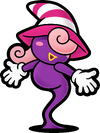 Vivian |
The youngest member of the Shadow Sirens. At first, she works for Sir Grodus, but eventually joins Mario's party to help him get his name, body, and teammates back, because Mario is kinder to her than her sisters. Since he is prevented from telling her who he is as a result of having his identity stolen, she does not realize he is her enemy until their final confrontation with the body thief. She retreats from battle upon learning this, but quickly returns after deciding that Mario has earned her loyalty. She can pull Mario into the shadows with her Veil technique, which is for all practical purposes identical to Lady Bow's Outta Sight move from Paper Mario. | Shade Fist 0 FP |
Punches an enemy and leaves it magically burned. Does not work on fire enemies, and those with lateral spikes. The burn inflicted will detonate bomb-type creatures. |
| Veil 1 FP |
Hides Mario and herself in the shadows to negate all damage for one turn. Next turn, Vivian will not be able to act. If Mario acts before Vivian uses this move, he will also be unable to act the following turn. | ||
| Fiery Jinx 6 FP |
Attacks all enemies with fire, penetrating their Defense Power and leaving them burned. This move is particularly effective against ice and undead enemies, heals fire foes, has no effect on Buzzy Beetles, Clefts, Bristles, and Chomps, and detonates bomb-type creatures. | ||
| Infatuate 4 FP |
Blows kisses at all enemies, possibly confusing them. | ||
 Admiral Bobbery |
A retired Bob-omb admiral who at first refuses to help Mario reach Keelhaul Key, but changes his mind when Mario delivers his late wife's letter to him. After Mario saves him from Cortez's underlings and gives him Chuckola Cola, he joins Mario's team. He possesses the same ability Bombette has outside of battle: with his bomb attack, he can destroy cracked walls, activate switches and attack enemies. However, he can be tossed upwards to walk on elevated ledges. Bobbery's Appeal tactic clears fog. | Bomb 0 FP |
Attacks the frontmost ground-bound enemy. This move is particularly effective against fire and undead enemies, can flip Clefts, detonates bomb-type foes, and clears fog, but has no effect on Buzzy Beetles. |
| Bomb Squad 3 FP |
Sets up three time bombs to explode on the next turn. | ||
| Hold Fast 4 FP |
Damages all enemies that make contact with Bobbery. | ||
| Bob-ombast 9 FP |
Powerfully bombs all enemies. This move will ground all foes, flip Clefts, detonate bomb-type creatures, and clear fog, but will not damage Buzzy Beetles. | ||
 Ms. Mowz |
A flirty Squeek cat burglar and badge hunter and the manager of the Lovely Howz of Badges. Mario and his teammates cross paths with her at Hooktail Castle, the Great Tree, and the Glitz Pit storeroom. She is an optional partner who joins Mario if he chooses to solve her trouble at the Trouble Center in Rogueport. To help her, Mario has to get the Attack FX B badge in Hooktail's lair and give it to Ms. Mowz.
She can also seek out hidden items and badges, and penetrate enemies' defenses like Watt from the first Paper Mario does, although the specifics are considerably different. She is the first partner in the Paper Mario series who does not have to join Mario's party in order for him to complete his quest. |
Love Slap 0 FP |
Attacks one ground-based enemy, ignoring their Defense Power. Does not work on fire enemies, and those with lateral spikes. |
| Kiss Thief 2 FP |
Steals a ground-bound enemy's held badge or item. | ||
| Tease 3 FP |
Makes all enemies dizzy. This move is particularly effective on aerial enemies. | ||
| Smooch 10 FP |
If successful, Mario recovers up to 10 HP. |
Battle system
Battles take place on a stage. In addition to the traditional turn-based combat, the characters on-stage interact with the scenery: sometimes the background falls (damaging all characters on stage and possibly making them dizzy), the audience helps Mario gain Star Power and may throw Mario useful items or pelt Mario and his partners with garbage, and lastly, some bosses even exploit the audience for their own benefit (for example, Hooktail will eventually eat some of the audience members to regain 10 HP, which causes all the other spectators to flee, therefore making it impossible to gain any Star Power).
Attacking enemies
While Mario and his partners are battling enemies, their attacks will deal extra damage and receive Star Power from an excited audience if the Action Command displayed onscreen is correctly performed. Stylish moves are extra Action Commands that, if executed, thrill the crowd even more, thus yielding even more Star Power: one must press ![]() at the right moment during a move. However, the game will never tell the player about Stylish moves, or when should one perform them, unless Eddy the Mask is talked to and the Timing Tutor badge is equipped.
at the right moment during a move. However, the game will never tell the player about Stylish moves, or when should one perform them, unless Eddy the Mask is talked to and the Timing Tutor badge is equipped.
Guarding
To perform the Guard Action Command, one must press ![]() or
or ![]() when Mario's opponent is about to strike him. Guarding reduces the damage he takes from enemy attacks and allows the player to resist status effects. The player must time it right, though.
when Mario's opponent is about to strike him. Guarding reduces the damage he takes from enemy attacks and allows the player to resist status effects. The player must time it right, though.
Guard: To perform a Guard move, the player must press ![]() to block enemy attacks, reducing the damage they deal by 1 HP, and also protecting Mario from negative status effects. The player has 8 frames (roughly 2/15 of a second) to Guard.
to block enemy attacks, reducing the damage they deal by 1 HP, and also protecting Mario from negative status effects. The player has 8 frames (roughly 2/15 of a second) to Guard.
Superguard: To perform a Superguard move, the player must press ![]() to block enemy attacks, negating the attack completely and sometimes damaging the attacker — generally a Superguard deals 1 HP of damage to a foe who employs a contact attack and none to foes who attack from a distance, but it does deflect Pokeys' ranged attacks back at them. The player only has 3 frames (or 1/20 of a second) to Superguard, making it more difficult to time than a regular Guard.
to block enemy attacks, negating the attack completely and sometimes damaging the attacker — generally a Superguard deals 1 HP of damage to a foe who employs a contact attack and none to foes who attack from a distance, but it does deflect Pokeys' ranged attacks back at them. The player only has 3 frames (or 1/20 of a second) to Superguard, making it more difficult to time than a regular Guard.
Status effects
Status effects are effects that alter a character's stats or behavior in battle. Since they can only occur within battles, they are automatically removed or healed once Mario and partners win a fight.
| Name | Effect |
|---|---|
Allergic |
Becomes unaffected by status effects, both positive and negative. |
Burn |
Loses 1 HP each turn. Is removed by a randomly-occurring stage effect involving falling water, and by the Frozen status ailment. Fire foes are immune to this ailment. |
Confused |
The victim has an approximately 50% chance each turn to ignore the AI or the player's orders and do something random and unexpected, including attacking allies. |
DEF-Up |
Raises Defense Power. |
Dizzy |
The victim's attacks have a 50% chance of missing their target. |
Dodgy |
The affected character has a 50% chance to dodge incoming attacks. |
Electrified |
The affected character will deal 1 HP of damage to attackers who make contact, and will often interrupt their attack — assuming the attackers are not electrified as well. |
Fast |
Allows the affected character to perform two actions each turn. |
Frozen |
The affected character is unable to do anything, and will take 1 HP of damage when the status expires. This ailment is negated if the Burn status is inflicted. Ice foes are immune to this ailment. |
Huge |
Attack Power is raised by 2. |
Immobilized |
The affected character is unable to do anything. |
Invisible |
The affected character cannot be attacked at all. |
Payback |
Attackers who make contact with the affected character will take half the damage dealt. |
Poison |
Loses 1 HP each turn. |
POW-Up |
Attack Power is raised. |
Sleep |
The victim is unable to do anything, but there is a chance that they will wake up prematurely if attacked. |
Slow |
The victim can only perform an action every two turns. The Fast status negates Slow. |
Soft |
Lowers Defense Power by 3. |
Tiny |
Lowers Attack Power by 2. |
Leveling up
Star Points
Every time Mario wins a battle, he earns Star Points. The amount he earns from each enemy or boss depends on his current level compared to the enemies he earns them from; as his level goes up, he earns less Star Points from them. If Mario's level is just under, matches or exceeds the enemy's, or reaches the maximum level, 99, he does not earn any Star Points from them at all. When Mario's Star Point meter reaches 100, the player can choose whether to upgrade Mario's Heart Points, Flower Points, or Badge Points. Upgrading HP or FP increases the upgraded stat by 5, and choosing BP raises Mario's BP by 3. Level 99 is the highest Mario can be at. Each stat has its own maximum value, which it cannot be upgraded beyond. For HP and FP, this value is 200, but for BP, this value is 99; however, it is impossible for the player to have all three stats simultaneously be at their maximum value at any one time, since the lack of level ups impedes at least one of the stats from being at its maximum.
Shine Sprites
Much like Paper Mario, there are items found in the overworld of Paper Mario: The Thousand-Year Door that, when collected, allow Mario to upgrade his partners to learn new moves and increase their HP. In this game, Shine Sprites fulfill this purpose. The price of upgrading a partner is always three Shine Sprites. There are 42 Shine Sprites altogether in the game.
The Audience
- Main article: Audience
The Audience determines how much Star Power Mario recovers. It consists of various enemies and allies, and sits and cheers as the group attacks. If Mario or his allies use the Appeal action or a Stylish move, they recover more Star Power. The audience is even exploited by various bosses: Hooktail, Cortez, and the Shadow Queen consume audience members to restore their HP, whereas Magnus von Grapple 2.0 uses spectators as ammo by launching them at Mario and his partners.
The Audience occasionally takes active participation in the battles; some spectators will attempt to toss Mario helpful items or pelt him with garbage, others will get on stage and cause a prop to fall or make combatants invisible, while others may incapacitate fellow audience members, making Star Power recovery more complicated.
Bingo!
- Main article: Bingo!
An icon appears next to Mario's Star Power Gauge whenever the player successfully uses the Action Command of an attack. If the player has two matching icons and if the player executes an additional Action Command, Mario can take the Bingo wheel for a spin.
Crystal Stars
| Crystal Star | Location | Guarded By | Power & SP needed | Description |
|---|---|---|---|---|
| Magical Map
|
Rogueport, in a small chest owned by a merchant | No one, but locked in a magic box that only the pure of heart could open. | Sweet Treat, 1 | Replenishes up to 7 HP for both party members and 8 FP, and cures all status ailments (except Immobilized and Down). |
| Diamond Star
|
Hooktail Castle | Hooktail | Earth Tremor, 2 | Creates an earthquake that damages enemies. If at least one gauge of the Action Command is completed, the tremor damages all grounded and low-hovering enemies. If done perfectly (all gauges completed), this move deals 6 HP of damage to all foes, regardless of their positions at the battle stage. This special move pierces Defense Power and ignores foes' invisibility. |
| Emerald Star
|
The Great Tree | Originally no one, Magnus von Grapple | Clock Out, 2 | If successful, immobilizes all enemies for a few turns. |
| Gold Star
|
Glitz Pit | Macho Grubba | Power Lift, 3 | Boosts Mario and his partner's Attack and Defense Power for a few turns. |
| Ruby Star
|
Creepy Steeple | Doopliss | Art Attack, 4 | The amount of damage dealt depends on how many times the player circles around the enemies using the |
| Sapphire Star
|
Pirate's Grotto | Cortez | Sweet Feast, 5 | Much like Sweet Treat, the player can replenish up to 24 HP and 24 FP for each party member, as well as cure all status ailments (except Immobilized and Down). |
| Garnet Star
|
Poshley Sanctum | Although Pennington guards the Poshley Sanctum, Smorg must be battled to get it. | Showstopper, 2 | If successful, instantly defeats all enemies. Does not work on enemies with more than 12 HP, mini-bosses, and bosses. |
| Crystal Star
|
X-Naut Fortress, originally in Rogueport | Possibly originally no one, Magnus von Grapple 2.0 | Supernova, 6 | Does up to 15 HP of damage to all enemies. The damage increases by 3 each time the player fills one gauge. This special move pierces Defense Power and ignores enemies' invisibility. |
Items
Items are objects that, if used, help Mario and his partners on their journey. They can restore their stats (for example, Mushrooms being capable of recovering their Heart Points, and Honey Syrups of recovering their Flower Points), temporarily boost stats (e.g., Power Punches raise Attack Power, and Courage Shells raise Defense Power), give the player status effects (like Repel Capes granting Dodgy, and Volt Shrooms bestowing electrification), damage enemies instead (for instance, with Fire Flowers and Ice Storms) or give them negative status effects (such as with Dizzy Dials and Sleepy Sheep). Mario can hold up to 10 items in his inventory, but he can store a maximum of 31 items at any Item Shop and withdraw them at any time he wishes to. The amount of items Mario can hold is doubled as soon as he collects the Strange Sack.
Also, non-boss enemies can hold items in battle, which they will use, usually as soon as they get a turn.
Badges
- Main article: List of badges in Paper Mario: The Thousand-Year Door
Badges are objects that Mario and his partners can equip, and therefore benefit from, throughout the course of the game. They can be purchased at the Lovely Howz of Badges or from Charlieton, traded for Star Pieces through Dazzle, won at the Pianta Parlor, or found in one of the places Mario and company visit. The ? Blocks containing badges in the field are red in color, unlike normal ? Blocks, which are yellow and contain coins or items.
When leveling up, Mario can gain Badge Points (BP), which allow him to equip badges he has already found. Some of the badges add new Jump or Hammer moves to Mario's commands during battle, among other abilities.
Badges can also affect Mario and his partners outside of battles. Certain badges can increase the amount of coins, flowers, hearts, or items that enemies drop after they are defeated. Foes might also carry badges in battle, which only Ms. Mowz can steal right away, though there is a likelihood that they might leave them behind once they are beaten.
Two special badges, the W Emblem and the L Emblem, can change Mario's clothing. With the W Emblem, Mario gets Wario's clothing, with the L Emblem, it results in Luigi's, and with both Emblems combined, he wears Waluigi's clothes.
If multiple copies of the same jump or hammer-based badge are worn at once, the FP requirement increases exponentially, whereas the Attack Power increases linearly.
Enemies and obstacles
Bestiary (Tattle Log)
- Main article: Paper Mario: The Thousand-Year Door bestiary
Enemy formations
In Mario's adventure in Paper Mario: The Thousand-Year Door, he encounters enemies on the field. When he engages battle with them, there are often other enemies that accompany the one that Mario encountered on the field.
Bosses
Bold signifies chapter bosses.
| Chapter | Name | HP | Attack | Defense | Location |
|---|---|---|---|---|---|
| Prologue: A Rogue's Welcome | Lord Crump (1) | 5 | 1 | 0 | Rogueport |
| Gus (optional) | 20 | 3 | 0 | Rogueport | |
| Blooper | 12 | 1 | 0 | Rogueport Sewers | |
| Chapter 1: Castle and Dragon | Gold Fuzzy Fuzzy Horde |
10 | 1 | 0 | Shhwonk Fortress |
| 20 | 1 (per attack) | 0 | Shhwonk Fortress | ||
| Red Bones Four Dull Bones |
5 | 3 | 1 | Hooktail Castle | |
| 1 (each) | 2 (each) | 1 (each) | Hooktail Castle | ||
| Hooktail | 20 | 5 | 1 | Hooktail Castle | |
| Chapter 2: The Great Boggly Tree | Vivian Marilyn (1) Beldam (1) |
10 | 1 | 0 | Boggly Woods |
| 12 | 2 | 0 | Boggly Woods | ||
| 9 | 1 | 0 | Boggly Woods | ||
| Magnus von Grapple | 30 | 2 | 1 | The Great Tree | |
| Chapter 3: Of Glitz and Glory | Armored Harriers | 6 (each) | 4 (each) | ??? (each) | Glitz Pit |
| Bowser (1) | 30 | 3 | 1 | Glitz Pit | |
| Rawk Hawk | 40 | 4 | 0 | Glitz Pit | |
| Macho Grubba | 60 | 4 | 0 | Glitz Pit | |
| Chapter 4: For Pigs the Bell Tolls | Atomic Boo (optional) | 40 | 4 | 0 | Creepy Steeple |
| Doopliss (1) | 40 | 4 | 0 | Creepy Steeple | |
| Doopliss (2) | 40 | 4 | 0 | Creepy Steeple | |
| Chapter 5: The Key to Pirates | Three Embers | 8 (each) | 3 (each) | 0 (each) | Keelhaul Key |
| Cortez | 20 x 3 | 4 | 1 | Pirate's Grotto | |
| Lord Crump (2) X-Nauts |
30 | 3 | 0 | X-Ship | |
| 6 (stack)/10 (horde) | 3 (stack)/5 (horde) | 0 (both) | X-Ship | ||
| Chapter 6: Three Days of Excess | Smorg | 50 | 5 | 1 | Excess Express |
| Chapter 7: Mario Shoots the Moon | Two Elite X-Nauts | 10 (each) | 5 (each) | 1 (each) | X-Naut Fortress |
| Magnus von Grapple 2.0 | 70 | 6 | 2 | X-Naut Fortress | |
| Chapter 8: The Thousand-Year Door | Dark Bones Four Dry Bones |
20 | 5 | 2 | Palace of Shadow |
| 8 (each) | 5 (each) | 2 (each) | Palace of Shadow | ||
| Gloomtail | 80 | 8 | 2 | Palace of Shadow | |
| Doopliss (3) Marilyn (2) Beldam (2) |
40 | 6 | 0 | Palace of Shadow | |
| 40 | 7 | 0 | Palace of Shadow | ||
| 30 | 5 | 0 | Palace of Shadow | ||
| Sir Grodus Grodus X |
50 | 7 | 1 | Palace of Shadow | |
| 3 (each) | 4 (each) | 0 (each) | Palace of Shadow | ||
| Bowser (2) Kammy Koopa |
70 | 7 | 2 | Palace of Shadow | |
| 50 | 5 | 0 | Palace of Shadow | ||
| Shadow Queen | 150 | 7 | 1 | Palace of Shadow | |
| Pit of 100 Trials | Bonetail (optional) | 200 | 8 | 2 | Pit of 100 Trials |
Other enemies
| Image | Name | Description | Locations |
|---|---|---|---|

|
Nibbles | Chain-Chomp-like fish that inhabit all bodies of water. If Mario jumps in the water, he will lose 1 HP, forcing him to exit it. | Hooktail Castle Keelhaul Key Palace of Shadow Petal Meadows Pirate's Grotto Poshley Heights Rogueport Rogueport Sewers The Great Tree |
Obstacles
| Image | Name | Description | Locations |
|---|---|---|---|

|
Bottomless pit | Falling into a pit causes Mario to lose 1 HP. During Bowser's platform levels, it immediately defeats Bowser, forcing him to start over. | Boggly Woods Rogueport Sewers World 1-X World 2-X World 3-X |

|
Electric tile | Stepping on the wrong tile will cause Mario to lose 1 HP. | X-Naut Fortress |
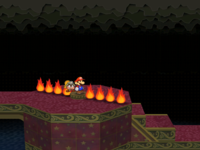
|
Fire Bar | A bar of fire that will force Mario back to the start if touched. In Bowser's third platforming level, it can be destroyed by Bowser's fire breath. | Palace of Shadow World 3-X |
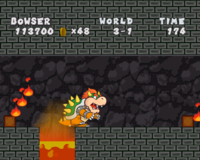
|
Lava | Molten rock that instantly kills Bowser, forcing him to start over. | World 3-X |

|
Spike Trap | Pointy obstacles. There are two kinds: retractable ones that cause Mario to lose 1 HP upon touching them, and stationary ones that block the way and cannot be touched at all since they are on raised platforms. | Hooktail Castle Palace of Shadow Pirate's Grotto Rogueport Sewers |
| File:PM-TTYD Spiked Ceiling at Hooktail Castle.png | Spiked ceiling | Ceiling covered in spikes which will fall gradually. If Mario doesn't escape in time, it will cause a Game Over. | Hooktail Castle |
| Water | A common obstacle that Mario can jump in, inhabited by Nibbles. | Hooktail Castle Keelhaul Key Palace of Shadow Petal Meadows Pirate's Grotto Poshley Heights Rogueport Rogueport Sewers The Great Tree | |
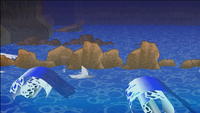
|
Wave | Water that comes in waves. It will force Mario back to the start it he comes in contact with one. | Pirate's Grotto |
Hidden block locations
In Paper Mario: The Thousand-Year Door, Mario can discover hidden ? Blocks throughout the game. Ms. Mowz's overworld sniffing ability is helpful in determining where they are. There are 15 invisible ? Blocks in total.
Selling prices
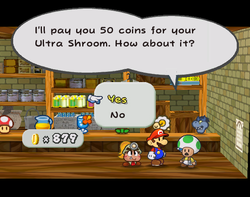
In Paper Mario: The Thousand-Year Door, Mario can sell items from his inventory to shopkeepers in the item shops in the game. Most items can be sold to the shopkeepers for a set price at every shop, however, some items sell at a higher price depending on the location of the shop and the item itself. Mario can make a profit if he purchases an item at a low price from one store, and sells it to another that buys it from him at a higher price. One Trouble Center trouble exploits this fact.
Side activities
Star Pieces
During the adventure, Mario and co. can collect Star Pieces by finding them in hidden spots, underneath chambers which he can use the Spin Jump to reveal, and earning them from other characters. Ms. Mowz is useful in finding the overworld Star Pieces. Mario can then trade them with Dazzle for Badges. There are 100 Star Pieces in the game.
Trouble Center
- Main article: Trouble Center
In Rogueport, there is a Trouble Center which offers the citizens' troubles for Mario to solve. An anonymous quest comes from Ms. Mowz and requires Mario to find a badge she is looking for but can not find. After this quest is completed, she joins Mario's team.
Zess T. recipes
- Main article: List of Zess T. recipes
Zess T. is a Toad chef who lives in the westernmost house in Rogueport Plaza. Mario accidentally breaks her contact lens when he approaches the entrance of Rogueport's west side, and in retaliation, she blocks the entrance until he makes it up to her. After Chapter 1, Mario can buy her a new one, and upon receiving it, she frees the way and goes home, where Mario can always ask her to cook him something with one ingredient. If her Trouble Center trouble is completed (available after finishing Chapter 4), she is able to cook with two ingredients at once.
The Pit of 100 Trials
The Pit of 100 Trials is an optional challenge. Before or after saving the world, Mario can take on the enemies found in the 100-basement floor area known as the Pit of 100 Trials. The enemies located on levels 51-99 are especially strong. Upon reaching floor 100, Mario discovers Bonetail, the long-lost relative of Hooktail and Gloomtail. After defeating Bonetail, Mario receives the Return Postage badge.
Similarities to Paper Mario
There are many similarities between the original Paper Mario and Paper Mario: The Thousand-Year Door, including these elements:
- Both games have an opening introduction before the title screen.
- The opening is identical to that of the previous game, right down to Parakarry delivering a letter from Princess Peach.
- The first partner of both games is a Goomba that gives Mario information about enemies, characters, and locations. They both have Headbonk, Tattle, and Multibonk as attacks.
- The second partner of both games is a Koopa Troopa. Both are obtained during Chapter 1, able to be shot out to hit switches and grab distant items, and use Shell Toss and Power Shell in battle.
- Both games have partners obtained in Chapter 3 that have first and last attacks that deal multiple low-powered hits: Lady Bow with her attacks, and Yoshi Kid with his Ground Pound and Stampede attacks.
- The fourth partner of each game allows the player to travel across gaps: Parakarry and Yoshi, respectively.
- Both games have a Bob-omb partner who is able to destroy cracked surfaces: Bombette and Bobbery, respectively.
- The fifth partner of both games allows Mario to become invisible to enemies: Bow and Vivian, respectively.
- Both games have a partner who is able to uncover hidden items, and whose basic attack pierces through Defense Power: Watt and Ms. Mowz, respectively.
- Both games have a partner who has betrayed an enemy to join Mario's party: Lakilester and Vivian, respectively.
- Both games have a partner who lets Mario ride them to move faster: Lakilester and Yoshi, respectively.
- Both games have some way to let Mario traverse through water: the partner Sushie and Boat Mode, respectively. Additionally, both abilities are obtained during Chapter 5 and can only be used to that end when a specific panel is stepped on.
- The main plot point of both games is to find seven star-shaped entities, each granting Mario special abilities.
- Both games have an upgrade system for Mario's Jump and Hammer attacks.
- In both games the player is able to play as Peach between Chapters. The player is required to dress Peach up as an enemy to learn secrets at one point. However, in Paper Mario: The Thousand-Year Door, Bowser's side-quest is separated from Peach's, as he is not the one who kidnapped her.
- As with the first Paper Mario game, a main antagonist encounters Peach disguised as a minion, and remarks on how she smells "too nice".
- Mario and Peach contact each other using friendly characters in both games. Twink helps her in Paper Mario, while TEC-XX does so in The Thousand-Year Door. In the end, both Twink and TEC develop feelings for Peach.
- Mario must solve a mystery in both games. A penguin is Mario's fellow detective in both.
- At one point in the games, Mario falls for a ploy created by the boss of a Chapter, which leads him to be confined in a cage alongside several other prisoners. The trap is a ? Block in Paper Mario, and a fake Puni pedestal in The Thousand-Year Door.
- Chapter 1 in both games features a fortress as the location of the boss, with both being located in peaceful, green plains. Additionally, both bosses terrorize the denizens of the local town (Koopa Village and Petalburg, which are both largely inhabited by Koopa Troopas). Both towns feature a distinctive, elderly Koopa Troopa (Koopa Koot and Kroop).
- The partner acquired in Chapter 2 in both games requires Mario to bring them an item.
- An oversized Clubba is the boss of Chapter 3 in both games, and both have a secret that involves making themselves powerful. Both are sought after by persistent female characters interested in finding lost persons (Lady Bow and Jolene). Furthermore, both Clubba characters have positioned security units to guard certain areas (Sentinels and Glitz Pit Security).
- In both games, at one point, Mario has to chase the Chapter 3 bosses (Tubba's Heart and Grubba).
- Chapter 4 in both games involves Mario accessing the storage room of a certain shop to make progress. It also involves widespread (and comical) mischief in a town; in Paper Mario, it is the Shy Guy frenzy that takes place in Toad Town, while in Paper Mario: The Thousand-Year Door, the denizens of Twilight Town are being turned into pigs at the toll of Creepy Steeple's bell.
- Moustafa and Flavio both give the player stones needed to reach an ancient, and rumored to be haunted, place. Also, both of the ghostly bosses (Tutankoopa and Cortez) try to intimidate Mario by uttering threats as he progresses through the level.
- Buying a Dried Shroom and another certain item along with it is a secret password in both games that must be entered in order to reach Moustafa and Don Pianta.
- Chapter 5 takes place on a tropical island with coconuts in both games, and both involve embarking on an expedition with one non-party character interested in treasure (Kolorado and Flavio). Also, in both games, this is when Mario's oldest partner joins him, and they both have to be rescued from being stuck in a tree before they do so (Sushie and Bobbery).
- The Chapter 5 bosses, Lava Piranha and Cortez, resemble each other, as Cortez's spine in his first form and Lava Piranha's stem are in the exact same position, and both of them have multiple forms. They are also accompanied by multiple entities, each with their own mechanics, attacks, and HP.
- In both games, Princess Peach must make something. Also, in both games, if she makes a mistake during the process of making it, it comes out wrong (making a cake for Gourmet Guy and making the invisibility potion, respectively).
- After the battle against Cortez is over, one of the Toad sailors tells everyone that he feels a "slight wind" coming from the cracked wall, just as Misstar does in the first game. The Bob-omb partner of both games is needed to blow the wall up. Also, the most frequently fought boss of both games (Jr. Troopa and Crump, respectively) shows up after Chapter 5 is completed.
- Chapter 6 takes place in a beautiful area and has a boss that can deal a high amount of damage when charged up: 12 for Huff N. Puff, 10 for Smorg. Also, both are blob-shaped and made up of a smaller species. Moreover, Ruff Puffs appear in the sixth Chapter of both games.
- Chapter 7 features a snowy region.
- Chapter 8 includes a fight against Bowser before the final battle, and Kammy Koopa is fought in both games.
- Both games contain puzzles in some places that are solved identically or similarly.
- The Riddle Tower shares many puzzles with the Crystal Palace, including blowing up cracked spots and walking through seemingly solid walls.
- The Palace of Shadow has puzzles and traps from Bowser's Castle, including an area wherein Mario only makes progress by following a pattern (though this is actually taken from the final castle level in Super Mario Bros.).
- Both dungeons in the final Chapters have rooms with stairs where Mario has to defeat B. Bill Blasters to reach the next room.
- The main villain of both games (those who kidnap Peach) has to be chased through a long stairway in the eighth Chapter.
- Mario's final battle is divided into multiple parts. At one point, each boss is invincible and Peach plays an integral role in negating that invincibility.
- Peach conveniently gets taken away in both games, right before Mario and company reach the hideaways of the games' main antagonists.
- In both games, there is a room where Mario can turn into 8-bit Mario, complete with Super Mario Bros. level 1-1 music playing.
- Both games have Merlon standing outside his house, waiting for Mario and his partners to show up, where he tells them about a dream that he had, and tells them to let him know if they find out the meaning of it. Afterward, an item that Merlon stored at the top of his house is retrieved by him.
- Both games feature a cooking system, and elderly, female Toad chefs, whose backstories involve deceased husbands and cakes.
- Both games have a spike-filled room where Bow's Outta Sight or Vivian's Veil must be used, and the position of the paths across the spikes are identical.
- Both games feature a boss who poses a threat by eating people (Tubba Blubba and Hooktail), and both of these have a secret weakness.
- Both games include a test during the Chapter 5 interlude that Princess Peach has to take, and that holds information that helps Mario in the future.
- Both games end with a parade led by Luigi (though in Paper Mario: The Thousand-Year Door, it is not a traditional parade, and is mainly a line of all of the characters' silhouettes, used as a way to show everyone).
- Both games' endings feature a scene in which Mario, after returning home from his travels, is shown hanging around with Luigi, having just told his brother the story of his adventure.
Quotes
- Main article: List of Paper Mario: The Thousand-Year Door quotes
- "Omigosh! Is… Isn't that a treasure map?! You HAVE to tell me where you got that!" - Goombella
- "And with that...pow! I'm gone!" - Lord Crump
- "Mmmmmmwee hee hee hee! I have no quarrel with you...but I simply can't allow you to hunt for the Crystal Stars." - Beldam
- "And then I, Grodus, will build a new world! A perfect, ideal world... Yes. A world made by me, about me, and for me! GAAACK ACK ACK ACK ACK!" - Sir Grodus
- "I'm... I'm sorry Sis. This Mario is the only person who's ever been kind to me..." - Vivian
Regional differences
Title theme
| File info |
| File info |
- The title theme was edited in international versions to flow smoother and make the drumroll more subtle than the Japanese version.
Technical changes
- There is no health warning screen when starting up the game in the Japanese version.
- There is no delay for when the player can press start on the title screen in the Japanese version.
- Holding
 when the player does not have the Ultra Boots prevents Mario from moving in the Japanese version.
when the player does not have the Ultra Boots prevents Mario from moving in the Japanese version.
- Similarly, holding
 when the player does not have the Super Hammer prevents Mario from moving in the Japanese version.
when the player does not have the Super Hammer prevents Mario from moving in the Japanese version.
- Similarly, holding
- On the Level Up screen, the cursor is set to FP by default in the Japanese version, while in the international versions, the player has to manually move the cursor to either HP or BP.
- In the Japanese version, Mario and his partners are fully healed at the end of Chapter 1, but at the end of all the other chapters, they do not get healed at all. In the international versions, Mario and his partners are fully healed at the end of each chapter except Chapter 8.[2]
- The international versions have more Stylish moves than the Japanese version. For example, there is no second Stylish after a normal jump in the Japanese version.
- Many of the items at the Pianta Parlor have different positioning in the menu in the Japanese version.
- The backtrace screen has some additional functionality in the international versions. In the international versions, the entire screen is used and also scrolls, while in the Japanese version only a part of the screen is used and it does not scroll.
- The Japanese version is missing the number of obtained badges/recipes and total badges/recipes on the Badges and Recipes screen.
- In the Pit of 100 Trials, when a player defeats an enemy, the pipes show up faster in the Japanese version.
- Koopook is moved to a different position (further to the left) in Hooktail Castle during his trouble in the Japanese version.
- Every enemy's stats stayed the same between all versions. However, the American version mistakenly claims that the Red Spike Top has 5 defense instead of 4, and that Rawk Hawk has 3 attack and 1 defense rather than 4 and 0, respectively. These mistakes were corrected in the European version.
- The English script mistakenly says the Zess Frappe and Icicle Pop restore 20 and 10 HP when they restore 20 and 15 FP in all versions, respectively.
- During pre-Chapter 5, Swindell the Bandit is moved to the far side of East Rogueport near the barrels. In the international versions, there is one less barrel, and Swindell's position is slightly altered.
- Giving Lumpy 200 coins early in the game leaves Mario with 500 coins later in the Japanese version and 600 coins later in international versions.
- All Fuzzies have horrible vision in the Japanese version, as they often do not even notice Mario when he goes by them. In the international versions, the Fuzzies have better vision and thus notice Mario more quickly. In addition, the Fuzzies move slower in the international versions.
- There is no slowdown when moving up slopes on rooftops with Yoshi in the Japanese version.
- At the end of Bowser's levels, fireworks are fired in the Japanese version but not in the international versions.
- In the original Japanese script and every other translation of the game, the final RDM email features an additional "hidden" section if the player scroll downs for an extended period of time. This portion was removed from the English translation, despite retaining the statement hinting at its existence.
- In the Japanese version, some item combinations that are given to Zess T. give different recipe results.
| Item Combination | Japan | International |
|---|---|---|
| Poison Shroom + Turtley Leaf | Mistake | Shroom Broth |
| Mushroom + Keel Mango | Mistake | Zess Dinner |
| [Mushroom/Life Shroom] + Peachy Peach | Mistake | Zess Dinner |
| Ultra Shroom + Peachy Peach | Zess Dinner | Zess Special |
| [Dried Shroom/Mushroom/Super Shroom/Life Shroom] + Fresh Pasta | Zess Dinner | Zess Special |
| Ultra Shroom + Fresh Pasta | Zess Special | Zess Deluxe |
| Poison Shroom + Point Swap | Ultra Shroom | Mushroom |
| Slow Shroom + Jammin' Jelly | Maple Super | Jelly Super |
| Mushroom + [Turtley Leaf/Golden Leaf] | Life Shroom | Shroom Fry |
| Super Shroom + [Turtley Leaf/Golden Leaf] | Life Shroom | Shroom Roast |
| [Life Shroom/Ultra Shroom] + [Turtley Leaf/Golden Leaf] | Life Shroom | Shroom Steak |
| Thunder Bolt + Thunder Rage | Trial Stew | Mistake |
- In the Japanese version, some items sell for different prices (in coins).
| Item Name | Shop It's Sold At | Japan | International |
|---|---|---|---|
| Couple's Cake | All shops | 30 | 10 |
| Gradual Syrup | Toad Bros. Bazaar | 7 | 8 |
| Healthy Salad | All Shops | 10 | 5 |
| Koopasta | All shops | 25 | 60 |
| Meteor Meal | All shops | 20 | 40 |
| Shroom Broth | All shops | 33 | 20 |
| Shroom Crepe | All shops | 50 | 100 |
| Spicy Soup | All shops except Northwinds Mart | 10 | 5 |
| Zess Dinner | All shops except Souvenir Shop | 10 | 7 |
| Zess Dynamite | All shops except Deepdown Depot | 30 | 20 |
| Zess Tea | All shops | 10 | 6 |
Area changes
Several areas had some changes made between the Japanese and international versions.
Prologue
- The X-Nauts who jump on Mario in the Prologue move faster in the Japanese version.
- In the Japanese version, the moving platforms in the Rogueport Underground (the one in the first area and the two in the room with the pipe to Petal Meadows) do not move as far to the left and right as the ones in the international versions.
Chapter 1
- Question #2 of the Thwomp quiz in Shhwonk's Fortress asks for the price of a Mushroom and a Fire Flower in the Japanese, French, German, Italian, and Spanish versions, as opposed to the price of a Mr. Softener and a Fire Flower in the English version. However, in the US Paper Mario: The Thousand-Year Door demo included in the Nintendo GameCube's Demo Disc Version 18, this question asked for the price of a Mushroom and a Fire Flower like in the other versions.
Chapter 2
- In the Japanese version, the right Pale Piranha on the screen where the Shadow Sirens are fought in Boggly Woods acts differently from the one in the international versions.
- In the Japanese version, when unlocking the blue cage door in the Great Tree, the game checks for and removes the Strange Sack from Mario's inventory if he has it (which permanently prevents it from being obtained again as there is only one in the game). This does not happen in the international versions. Also in the Japanese version, after unlocking the blue cage door, there are several frames where Mario is able to move around freely.
- In the Japanese version, Punio's textbox when he thinks about how to reveal the secret entrance does not pause.
- In the room where the player has to hammer the switches to gain access to the Super Boots room, in the Japanese version the 4 statues all have Punis on them before hitting the switches, but in the international versions the 4 statues have the following (left to right) on them before hitting the switches: Puni, Star, Moon, Sun.
Chapter 3
- In the Glitz Pit, all fights (excluding ones that start with special cutscenes, such as The Goomba Bros. and The Armored Harriers) start about 2 seconds faster in the Japanese version when compared to the international versions.
- In the Japanese version, when returning to Rogueport from Glitzville, the entire cutscene is about 7 seconds longer than in the international versions.
- During Peach's section right after Chapter 3, when leaving the dressing room to return to TEC after talking to Grodus, the player can move while the door is opening in the Japanese version.
Chapter 5
- In the Japanese version, Mario can get the Keel Mango from the trees at Keelhaul Key at any time. In the international versions, the chapter must be completed first. This was most likely changed to ensure that Flavio ends up getting the Coconut rather than the Keel Mango as both items are tropical food and giving Flavio any food item that is not a Coconut results in him asking for something more tropical.
- One Flower Fuzzy on the screen with the blue pipe in Keelhaul Key was removed in the international versions.
- The Flower Fuzzy on the screen with the two Putrid Piranhas continues to move around if it falls down in the Japanese version, while it stays still in the international versions.
- In Pirate's Grotto, the chest behind the waterfall contains a Damage Dodge P in the Japanese version. In the international versions, this is a Defend Plus P.
- In the black chest room in Pirate's Grotto, when Mario defeats the Embers, the key randomly falls to the left or right in the Japanese version. In the international versions, it simply falls straight down.
Chapter 6
- On Day 3 of the Excess Express, Mario gets an email in the dining car in the Japanese version. In the international versions, Mario gets this email to the right of his room.
- When the Smorgs appear when talking to the Engineer, they do not cover the right part of the window in the Japanese version.
- In the outside room at Riverside Station with the Poison Pokeys and Ruff Puffs, there is a block that can be jumped on to hit a hidden block that contains a Thunder Rage. In the Japanese version, this block is a breakable block, and breaking it causes it to stay broken until the player leaves Riverside Station. The international versions made this block unbreakable.
Chapter 7
- X-Naut Fortress's third puzzle room has a safe path two squares long in the Japanese version and three squares long in the international version, thus slightly reducing its difficulty.
- On the moon, on the screen with the pipe, blowing up the rock containing the pipe causes a small cutscene to play in the Japanese version. This cutscene does not occur in the international versions.
Chapter 8
The changes made consist of the fight against the Shadow Queen:
- In the Japanese version, none of the Shadow Queen's attacks can be superguarded against.
- During the first phase of the Shadow Queen fight, she changes to her true form after dealing at least 39 damage to her in the Japanese version. In the international versions, this happens after dealing at least 61 damage.
Aesthetic changes
- Some items were redesigned in international versions:
- Super Luigi 5 is red instead of orange.
- The katakana on the Wrestling Mag are replaced with scribbles.
- The Power Rush badge has a different letter for every language.
- Vintage Red was renamed Chuckola Cola and recolored purple to resemble soda instead of wine.
- The Boos Peeka and Lahla wear bunny ears in the Japanese version, but cat ears in international versions to avoid resembling a bunny suit.
- TEC-XX's camera "eye" is blue instead of red in international versions to tone down similarities to the HAL 9000.
- Larson's Toad chalk outline and bloodstains in his house were removed from international versions to remove violent undertones.
- In the English and German scripts, Vivian is referred to with feminine pronouns and has no mention of being a male-to-female gender dysphoric.
- The Shadow Queen is slightly more formal and condescending in the English script.
- Before the battle against Shadow Queen, if Mario chooses to be her servant, after her spell has casted on Mario, Mario's sprite changes to the same as Doopliss's appearance when impersonating as him in the Japanese version, notably for the evil-looking appearance, and the effects from L Emblem and W Emblem are also removed (like how Doopliss's fake copy of Mario cannot change colors either). However, in the international version, Mario keeps the same angry pose before the spell, and his appearance and color remain unchanged.
- A few cutscenes involving flashing lights were edited down in the international versions, probably to reduce the chance of players getting epileptic seizures:
- The flashing lights during the first Shadow Queen cutscene were reduced.
- The flashing lights during the cutscene in the room that makes the Emerald Star appear were reduced.
- However, the animation for Showstopper, which despite being arguably worse than the two stated above, was not edited.
- PAL versions have additional differences from all NTSC versions. Only NTSC versions can be played in progressive scan mode, and only PAL versions can be played in 50Hz mode, using the same method to activate each. The American and Japanese versions have their languages locked to English and Japanese, respectively, while the PAL version can additionally be played in Spanish, French, Italian and German depending on the GameCube settings. Also, in NTSC versions, Mario has two different talking animations, one involving him raising his hand and one involving him moving his mouth, and each one is used in different scenarios. Only the "mouth moving" one is used in the PAL version, however, to avoid resemblance to the Nazi salute.[citation needed]
Pre-release and unused content
Reveal trailer
This game was initially titled Paper Mario 2 and featured a far different logo, one reminiscent of the original Paper Mario's logo.
Part of the original trailer shows an extra ledge above the pipe in the room directly east of the Thousand-Year Door, with an HP Plus badge on it. It could be accessed via a moving platform which had a wall over it halfway, which appeared to be passable with help from Vivian. Also, Beldam and Doopliss were originally going to be fought somewhere in Riverside Station. The trailer also showed that Item Shops would be labeled with Mushrooms, much as in Super Paper Mario, rather than the Fire Flowers seen in the final game. Red Bones was initially named "Red Koopa Skeleton." In the same trailer, one can see that "Tornado Jump" was initially called "Hurrican Jump".[sic] The status element Slow had a different icon, a snail instead of a sad purple face.
An early location of the HP Plus Badge.
Hooktail Castle Notice how the final game, the door is just open from the start.
A battle in Hooktail's Castle. Notice Hurricane is spelled wrong.
Glitches
- Main article: List of Paper Mario: The Thousand-Year Door glitches
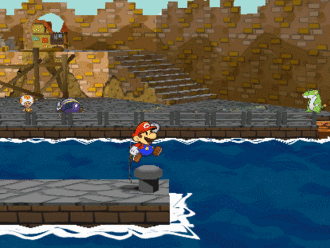
Koops splashing on Dry Land
At any location where Mario can fall into the river and the player can talk to an NPC, the player should stand near the river and use Koops's ability, holding ![]() so he remains in place. Without letting go of the button, the player should walk away so that Koops is offscreen, and talk to a character in the same area. When the player is done, Koops respawns next to Mario. There is a splash animation even on dry land.
so he remains in place. Without letting go of the button, the player should walk away so that Koops is offscreen, and talk to a character in the same area. When the player is done, Koops respawns next to Mario. There is a splash animation even on dry land.
Staff
- Main article: List of Paper Mario: The Thousand-Year Door staff
Intelligent Systems developed the game with Nintendo publishing it. The music is credited to Yoshito Hirano and Yuka Tsujiyoko.
Reception
Overall, Paper Mario: The Thousand-Year Door received very positive reviews from critics, who praised its enjoyable story, characters, and humor, in addition to its battling system, multiple side-quests, and soundtrack.
| Reviews | |||
|---|---|---|---|
| Release | Reviewer, Publication | Score | Comment |
| Nintendo GameCube | Peer Schneider, IGN |
9.1/10 | With Mario & Luigi: Superstar Saga finished and stashed away, I was ready for another opportunity to venture into Mario's RPG realm. While there's plenty of room for better presentation (Paper Mario Revolution, anyone), this game is an absolute blast to play. Get past the slow-moving first chapter and some clunky NPC path finding routines in chapter 2 and you'll be hooked. The story is funny, the gameplay varied, and the world so charming, you'll want to explore every last corner of it. Add to that plenty of playable characters and sidekicks, some great cameos, a memorable score loaded with classic melodies, and a quest that runs a good 30 hours long, and you've got another winning offshoot in the mighty Mario franchise. Paper Mario: The Thousand-Year Door improves on its predecessor in every way and takes the cake as the best Mario RPG yet. Highly recommended. |
| Nintendo GameCube | Jeremy Parish, 1UP |
8.5/10 | Paper Mario 2 is clearly a game for fans, created by people with genuine affection for the Mario legacy...it's a testament to the diversity of the medium that in a season marked by realistic, violent and often grim video games like GTA, Halo 2 and Def Jam: FFNY, a game like Paper Mario can be so willfully charming, harmless and child-friendly in appearance and still make for a compelling, sophisticated experience. It's a must-have for Mario nuts, and is worth a look for everyone else. With its simple, brilliant graphics, impressive sound design and laid-back but addictive gameplay, Paper Mario 2 is an excellent sequel -- and a great game in its own right. |
| Nintendo GameCube | Tom Bramwell, Eurogamer |
9/10 | Of course, you've long since realised how this was going to end. But we're trying. We're trying to put ourselves in the minds of people who would treat this game with prejudice and toss it back in our laps and say "No thanks", or just turn up on the comments thread and tell us it's crap, but quite honestly you would have to actually hate Mario, or Nintendo, in order for this not to entertain you. Whether you think you like role-playing games or not. Fair enough, if Mario has stolen your girlfriend, keyed your car, broken the lead in your pencil and signed you up to the Britannia Music Club, we don't expect you to buy this. But the only things we can say against it are specialised nit-pickings. We were honestly going to mention this one occasion when we had to redo something relatively straightforward five times due to our own cackhandedness. That's about as bad as it got for us. Otherwise our only feelings of concern stemmed from our fear that we might not get far enough in quick enough time to be able to tell you with any authority whether Paper Mario: The Thousand-Year Door is every bit as good as Intelligent Systems could make it. Well, we did, so we can. And it is. |
| Nintendo GameCube | Miguel Lopez, Gamespy |
4/5 | If I had to fault Paper Mario: The Thousand-Year Door on something, it would be its reliance on backtracking. You have to do a frightful amount of it in most of the scenarios. At best, doing so allows you to access spots in previous areas that you perhaps weren't able to before. At worst? You'll have to perform some tricky platforming one time more than you feel you should. But in the end, this is what the games that inform its design are like, so I guess we have to take the good with the bad. And when it comes to Paper Mario: The Thousand-Year Door, it's mostly all good. If you have a history of playing 2D side-scrollers, this game will make you remember just why you loved them. And if you have a soul, then this game will make it feel all warm and fuzzy. |
| Aggregators | |||
| Compiler | Template:Nowrap | ||
| Metacritic | 87 | ||
| GameRankings | 88.05% | ||
Gallery
- For this subject's image gallery, see Gallery:Paper Mario: The Thousand-Year Door.
Media
- For a complete list of media for this subject, see List of Paper Mario: The Thousand-Year Door media.
| File info 0:15 |
| File info 0:30 |
| File info 0:30 |
References to other games
- Donkey Kong: One of the badges is named "Jumpman", referencing to how Mario was alternatively named in this game. An audience member in the Glitz Pit also calls out Jumpman when Mario reaches Rawk Hawk a second time. In addition, although not in the game itself, the Official Nintendo Power Player's Guide alluded to Mario's encounters with the titular ape from the game where they mentioned that the X-Nauts thought they could dissuade Mario with various platforms at high places, but they had not heard of his exploits against "a certain ape."
- Super Mario Bros.: At the X-Naut Fortress in the Changing Room, Mario and company can change into an 8-bit sprite of themselves, along with the Super Mario Bros. music playing in the background. Hamma also mentioned that his grandfather was at World 7-1. Bowser's gameplay is also a direct parody of this game. In the Japanese and French versions of the game, the video-game obsessed Toad from Petalburg refers to Super Mario Bros as his favorite game for the Famicom and Nintendo Entertainment System, respectively, also urging Mario to play it in the latter version. Bowser's level segments also play very similarly to how they did in Super Mario Bros., including the Overworld and Underwater themes that play.
- Famicom Disk System boot up: During the Peach transition scene for Chapter 5, when Peach is invisible and retrieves a disc from Grodus's office, the computer screen displays a scene of Mario and Luigi fighting over a light switch, referring to the boot up screen for the Famicom Disk System if the player did not input a disk beforehand.
- Super Mario Bros. 3: The Grass Land theme is arranged as part of the music that plays during the opening cutscene. Whenever Jolene (while under the alias of "X") sent Mario an e-mail, the Ice Land map screen theme would play. The music that plays when Mario is riding the blimp is a cover of the athletic theme from this game. This game also included Boomerang Bros., Fire Bros., and Boos, which originated from this game. Also, the "king saved" music can be heard in Luigi's story telling theme. Also like Super Mario Bros. 3, the game's story is implied to be a stage play (although it is more direct than in the former game, as it was only stated by Shigeru Miyamoto in the former case). In addition, Peach after each chapter ends up sending (e-)mail to Mario with advice for the next level, with her final mail upon completing all objectives being intercepted by the main villain, similar to in Super Mario Bros. 3. Bowser's theme song contains a cover of the castle theme.
- Super Mario World: Whenever Peach sends Mario an e-mail, the title screen theme would play. Whenever Mario gets an e-mail from other people, part of the epilogue theme (from when a Koopaling castle is beaten) plays. When Mario wins a battle, the "level clear" sound plays.
- Super Mario World 2: Yoshi's Island: Blue Bandits appear as NPCs. Atomic Boo closley resembles Bigger Boo from this game.
- Super Mario 64: In the first Princess Peach interlude, Peach is singing the Inside the Castle Walls theme from this game when she is in the shower.
- Paper Mario: Parakarry makes a brief cameo at the beginning of the game, and delivers a letter to Mario from Peach, just like the previous game. Lady Bow also makes a cameo appearance, and makes a direct reference to Boo's Mansion, as well as the adventure they had. There is also a random Toad at the Excess Express (after Chapter 6 is completed) that asks Mario a quiz question, ("What did Bowser steal in the first Paper Mario?"), and the answer is, "Star Rod". The video game-obsessed Toad kid from Petalburg also mentions that he has been playing the game, describing Bow as the "cutest Boo of ALL TIME!!!" Jr. Troopa also appears in the background in the picture that Zip Toad attached to his e-mail. Gulpits are also given a reference when Grubba exclaims, "GREAT-GALLOPIN' GULPITS!". A Ratooey at Rogueport Harbor who went on a quest for oil in Dry Dry Desert can tell Mario about this adventures at the end of the game. Every part is a chapter of Paper Mario game. In the email he sends to Mario after finding him, Koopook says he is now hiding in Crystal Palace in the Japanese version; however, this last reference is lost in the English translation, as Crystal Palace is instead translated as "Goomstar Temple". Kolorado was a student of Professor Frankly, and the former's deceased father appears as a crumpled Dull Bones in Hooktail's Castle, which Koops confuses for his own father. One of the houses in Poshley Heights has a model of the K64.
- Mario Kart: During Luigi's story about Circuit Break Island, he tells Mario he had to sign up for a Kart race, and mentions he had driven karts before, giving reference to the Mario Kart series.
- Luigi's Mansion: A crow in Twilight Town says he will set up an estate pay site named Luigi's Mansion, and his crow friend says that "he's heard that name somewhere before", referencing this game.
- Super Smash Bros. Melee: In the Spanish version of the game, Rawk Hawk's victory gloat after beating The Koopinator specifically referenced Super Smash Bros. Melee (in all other versions, he simply says they are better off playing video games without naming one in particular).
- Super Mario Sunshine: Toadsworth, Piantas, and Shine Sprites appear in the game to upgrade Mario's partners. The parrot in Creepy Steeple randomly says the infamous translation of "Shine get!".
- Mario & Luigi: Superstar Saga: Chuckola Cola is an item in this game, referring to the game it has been appeared first. The "Super-Guarding" ability was likely inspired by the ability to counter enemies' attacks in Superstar Saga. Mario gaining field abilities to use in battle (Spin Jump, Spring Jump, Super/Ultra (spin) hammer) as special FP consuming attacks were also likely inspired by field abilities in Superstar Saga being used in battle as Bros. Attacks. One of Bowser's options during his conversation with Pennington during the Chapter 7 interlude is The Shadow Thief, a reference to Popple. The difference of the naming methods between the English and Japanese titles are similar to this game, as the English titles of both games have a subtitle under the series names (Mario & Luigi and Paper Mario respectively), while the Japanese titles simply have the term "RPG" under the series names.
References in later games
- Super Paper Mario: This game is alluded to by a video game-obsessed Toad in Petalburg. At the end of the game, he states that he has been playing "the new Paper Mario game" called Super Paper Mario, which was released in 2007 for the Wii, and that it will be pleasing to fans of Luigi, which hints that the game was already in production and/or planning stages at the time Paper Mario: The Thousand-Year Door was in development. All seven partners from Paper Mario: The Thousand-Year Door make cameo appearances as Catch Cards that are won by completing the Duel of 100 at Sammer's Kingdom. Francis also has plush toys of the Yoshi (in all colors), Vivian, Bobbery, and Pennington, along with a poster of Petuni. In Francis' list of things to buy, Rawk Hawk was given a reference when he stated that he wants a DVD called, "Harder than Bedrawk: The Rawk Hawk Story". Francis also stated that he wants a Ms. Mowz doll with "real-smooching action", an Excess Express train set, and a Magnus Von Grapple action figure. Francis also happens to watch "Starship X-Naut" and "The Grodus Chronicles". Also, Fracktail and Wracktail, themselves are homages to Hooktail and Bonetail. Additonally, there is also a Sammer Guy who calls himself "Laughing X-Naut" and another who calls himself "The Thousand Year Roar". Lastly, Slim's ability to make Mario, Peach, Bowser, or Luigi thin is a reference to the second curse in Paper Mario: The Thousand-Year Door.
- Super Smash Bros. Brawl: Goombella, Mini-Yoshi, Vivian, and Rawk Hawk appear as Stickers. Goombella also has her own trophy. Also, the words, "CRUMP" and "RAWK" appear in the random name selection, which are possible references to Lord Crump and Rawk Hawk.
- Paper Mario: Sticker Star: In the level Shy Guy Jungle, there is a pile of garbage with many letters. One letter is written by Goombella and it states: "Observations on the Ancient Civilization of the Chomp Ruins."
- Super Smash Bros. for Nintendo 3DS: The S.S. Flavion appears as a variation of a Paper Mario stage in this game. A Big Blooper based on the boss also appears in the stage variation's background. An arrangement of the Rogueport theme is also part of the stage's main song.
- Super Mario 3D World: The Fuzzy Horde, which debuted in this game, returns in several levels.
- Mario & Luigi: Paper Jam: Paper Mario's Airplane and Paper Modes return. During Trio Grab, Paper Mario turns into a tube, similar to Tube Mode. He can also turn into a paper drill during Trio Drill, which is similar in concept to the paper abilities from this game. When Paper Mario meets the Mario Bros., he performs a Spring Jump. Paper Mario borrows his blocking and KO'd animations from this game. The trio gains Star Points by performing Action Commands correctly, which is similar to how Paper Mario and his partners had to appeal to the audience by doing the same thing, and by also being stylish. The stage where Mario, Luigi and Paper Mario stand when they level up is similar to the stage from this game's battles, down to the yellow stripes on the curtains.
- Paper Mario: Color Splash: Peach summons Mario over to the current destination due to a discovery she made (although in this case Peach personally has Mario come along). Peach also ended up abducted shortly after bringing Mario along (although in that case, Mario does witness Peach's abduction). She also sends mail giving some hints about the main villain's plan and the next destination that Mario should head towards in the form of Holo-Peaches, and her last mail has Peach's message being cut off by the main antagonist (Black Bowser) just as Peach was about to give key details about his villainous plan. In addition, a character gets possessed by a grave evil (in this case, Bowser via Black Paint, while in Paper Mario: The Thousand-Year Door, it was Peach who was possessed by the Shadow Queen). Also, the Big Paint Stars serve a similar function to the Crystal Stars.
- Paper Mario: The Origami King: Peach's design from The Thousand-Year Door appears as a photo. Additionally, when Mario and Bob-omb interact with the steering wheel on the Princess Peach, the latter mentions that he dreams of being an admiral someday, in reference to Admiral Bobbery.
Names in other languages
| Language | Name | Meaning | Notes |
|---|---|---|---|
| Japanese | ペーパーマリオRPG[?] Pēpā Mario Āru Pī Jī |
Paper Mario RPG This naming method is similar to Super Mario RPG and the Japanese name of Mario & Luigi: Superstar Saga. |
|
| Chinese (traditional) | 紙片瑪利歐RPG[3] Zhǐpiàn Mǎlì'ōu RPG |
Paper Mario RPG | |
| French | Paper Mario: La Porte Millénaire[?] | Paper Mario: The Millennium Door | |
| German | Paper Mario: Die Legende vom Äonentor[?] | Paper Mario: The Legend of the Aeon Gate | |
| Italian | Paper Mario: Il Portale Millenario[?] | Paper Mario: The Millennium Portal | |
| Korean | 페이퍼 마리오 1000년의 문[?] Peipeo Mario 1000(Cheon)nyeon-ui Mun |
Paper Mario The Thousand-Year Door | |
| Spanish (NOE) | Paper Mario: La Puerta Milenaria[?] | Paper Mario: The Millennium Door |
External links
References
| Nintendo GameCube games | |
|---|---|
| Super Mario franchise | Luigi's Mansion (2001) • Super Mario Sunshine (2002) • Mario Party 4 (2002) • Mario Golf: Toadstool Tour (2003) • Mario Kart: Double Dash!! (2003) • Mario Party 5 (2003) • Paper Mario: The Thousand-Year Door (2004) • Mario Power Tennis (2004) • Mario Party 6 (2004) • Dance Dance Revolution: Mario Mix (2005) • Mario Superstar Baseball (2005) • Mario Party 7 (2005) • Super Mario Strikers (2005) |
| Donkey Kong franchise | Donkey Konga (2003) • Donkey Konga 2 (2004) • Donkey Kong Jungle Beat (2004) • Donkey Konga 3 JP (2005) |
| Wario franchise | Wario World (2003) • WarioWare, Inc.: Mega Party Game$! (2003) |
| Other | Super Mario 128 (2000, demo) • Super Smash Bros. Melee (2001) • Nintendo Puzzle Collection (2003) • NBA Street V3 (2005) • SSX on Tour (Nintendo Village) (2005) • Donkey Kong Racing (cancelled) • Diddy Kong Racing Adventure (cancelled) |
